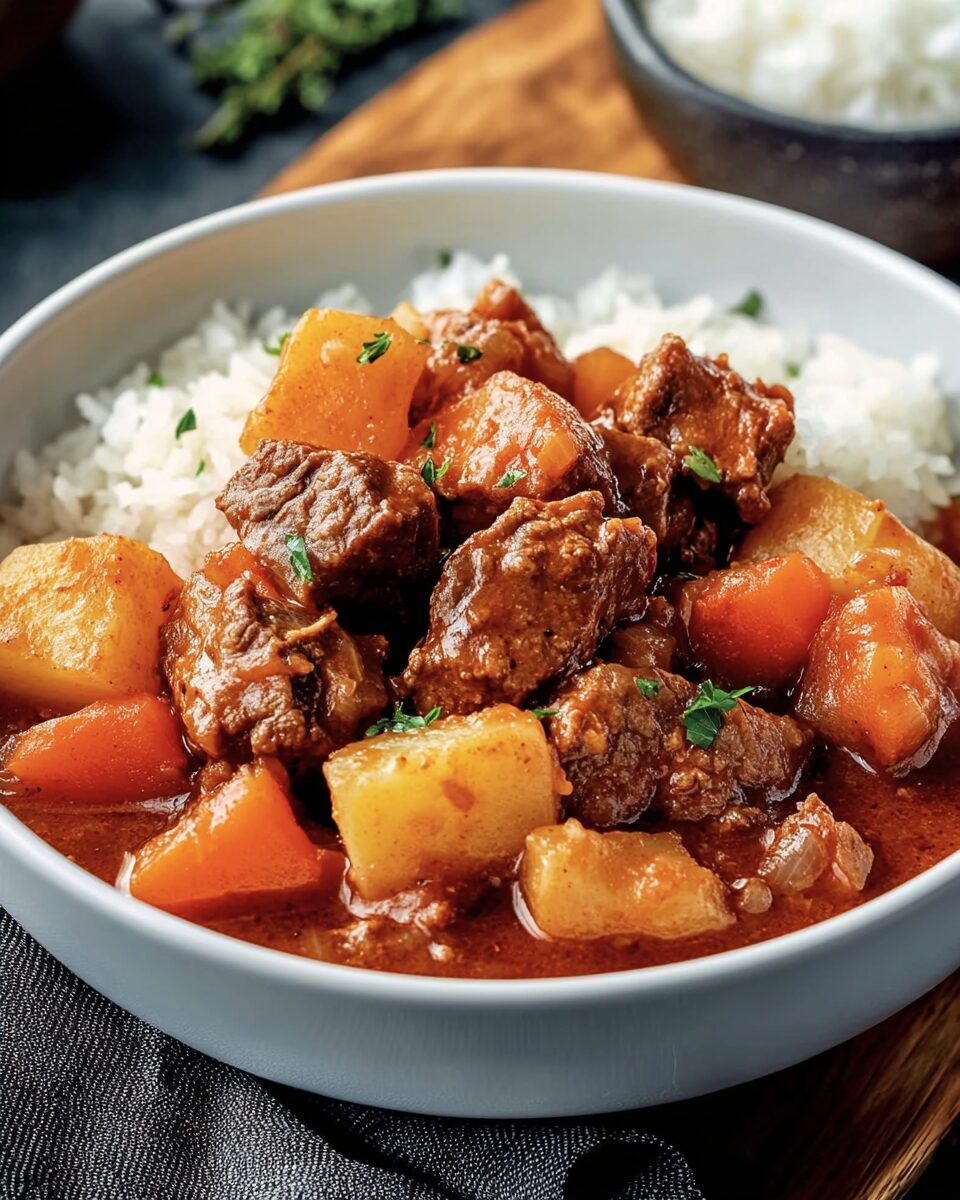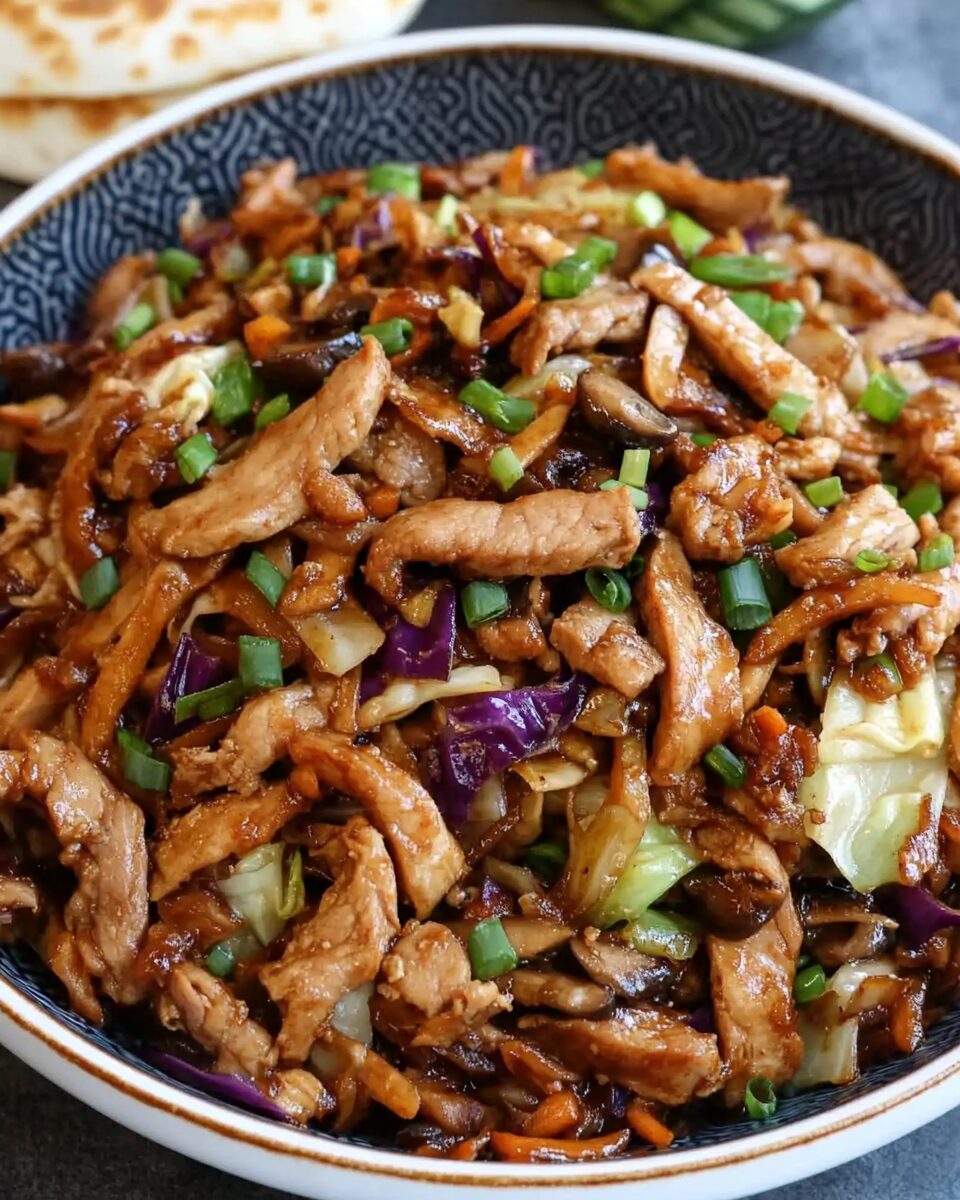This Hawaii-Style Beef Stew is a hearty island comfort food staple, made with fork-tender beef simmered in a tangy, tomato-rich gravy alongside chunky potatoes, carrots, and onions. Inspired by classic Hawaiian plate lunch flavors, it’s a soul-satisfying dish that’s perfect for cozy family dinners or a taste of the islands any day of the year. Its balance of acidity and richness sets it apart from traditional beef stews.
Full Recipe:
Ingredients
-
3 lbs boneless beef chuck, trimmed & cut into 1½-inch cubes
-
Kosher salt & freshly ground black pepper
-
Neutral oil (vegetable or canola), for browning
-
1 large yellow onion, diced
-
4 garlic cloves, minced
-
2 tbsp tomato paste
-
½ cup red wine (optional, for deglazing)
-
1 (28 oz) can crushed tomatoes
-
2 cups beef stock
-
3 tbsp Worcestershire sauce
-
1 tbsp sugar (optional, to balance acidity)
-
4 large Yukon gold potatoes, peeled & cubed
-
5 large carrots, peeled & cut into chunks
-
2–3 bay leaves
-
Optional: Hawaiian sea salt or fish sauce, to taste
Directions
-
Brown the Beef:
-
Season beef with salt and pepper. In a large Dutch oven, heat oil over medium-high and brown the beef in batches. Transfer to a plate.
-
-
Sauté Aromatics:
-
In the same pot, add onions and cook until soft (5–6 minutes). Add garlic and tomato paste; cook 2 more minutes.
-
-
Deglaze:
-
Pour in wine (if using) to deglaze, scraping the brown bits off the bottom.
-
-
Simmer the Stew:
-
Add crushed tomatoes, beef stock, Worcestershire sauce, sugar (if using), and bay leaves. Return beef to the pot. Bring to a boil, then reduce to a simmer. Cover and cook for 1½ hours.
-
-
Add Veggies:
-
Stir in potatoes and carrots. Simmer uncovered for another 45 minutes to 1 hour until vegetables and beef are very tender.
-
-
Season & Serve:
-
Adjust seasoning with more salt, pepper, or a splash of fish sauce for umami. Serve hot over white rice or with Hawaiian rolls.
-
Nutrients (Estimated per serving)
-
Calories: ~450–550 kcal
-
Protein: ~35–40g
-
Fat: ~20–25g
-
Carbohydrates: ~30–35g
-
Sodium: Moderate to high (depending on added salt and Worcestershire)
A Unique Island Twist on a Classic Dish
What makes Hawaii-Style Beef Stew truly stand out is its bold tomato base and slightly tangy finish. It’s a dish that reflects Hawaii’s diverse culinary heritage, drawing on American, Asian, and Pacific Islander influences. While the dish may seem familiar to mainland diners, its taste tells a different story: one that’s brightened by crushed tomatoes, deepened with Worcestershire sauce, and brought together with a long, slow simmer that coaxes out every ounce of flavor from the beef and vegetables.
This isn’t just a stew—it’s an experience. Often served over fluffy white rice or alongside soft Hawaiian sweet rolls, this stew is about comfort, nourishment, and a bit of nostalgic island magic.
Why You’ll Love This Stew
-
Fork-Tender Beef: Thanks to the long simmer and the perfect choice of cut (beef chuck), every piece of meat becomes luxuriously tender.
-
Balanced Flavors: The tangy tomato base cuts through the richness of the beef, while optional sugar and Worcestershire sauce create a savory-sweet balance.
-
Vegetable Hearty: Loaded with Yukon gold potatoes and thick chunks of carrot, this stew is as filling as it is flavorful.
-
Perfect for Leftovers: The flavors continue to develop overnight, making it even better the next day.
-
Authentic Hawaiian Inspiration: It brings a taste of the islands right to your dinner table—no airfare needed.
Building Flavor, Step by Step
From the first sizzle of beef browning in a hot pot to the final simmer with carrots and potatoes, each step in this recipe is intentional.
Browning the Beef: Starting with well-seasoned beef cubes seared in batches ensures rich, deep flavor. This step is crucial—not just for texture but for building a flavorful base.
Sautéing Aromatics: The diced onions and garlic create the aromatic backbone of the stew. Tomato paste adds concentrated flavor and depth, giving the stew its signature red hue.
Deglazing with Wine (Optional): Red wine lifts the fond (the browned bits stuck to the bottom of the pan), adding acidity and complexity to the broth. If you skip the wine, beef stock will still deglaze effectively, but the flavor will be slightly mellower.
Tomato-Rich Base: Crushed tomatoes, beef stock, Worcestershire sauce, and bay leaves create the heart of the stew. The addition of sugar is optional but helps soften the acidity of the tomatoes, especially if you’re using a more tart variety.
Slow Simmer: Letting the beef stew gently over low heat for 90 minutes allows it to tenderize while absorbing all the flavors of the sauce.
Vegetable Timing: Adding potatoes and carrots later in the cooking process keeps them intact and prevents overcooking. This method ensures the vegetables absorb just enough flavor from the broth while maintaining their texture.
Final Touches: Seasoning with Hawaiian sea salt or a splash of fish sauce enhances the umami and brings a subtle layer of island authenticity.
Ideal Pairings and Serving Suggestions
Hawaii-Style Beef Stew is traditionally served with white rice, creating a warm and comforting plate lunch-style meal. Other great pairing options include:
-
Hawaiian Sweet Rolls: Perfect for soaking up the tangy tomato gravy.
-
Macaroni Salad: A creamy, cool contrast to the hot stew—a plate lunch essential.
-
Steamed Jasmine or Brown Rice: A healthier grain option that still complements the rich sauce.
-
Garlic Noodles or Soba: A fusion twist that honors Hawaii’s multicultural roots.
To complete the meal, consider a simple green salad with sesame dressing, grilled pineapple, or a chilled passionfruit or guava drink for that extra island vibe.
Make-Ahead and Storage Tips
This stew tastes even better the next day, making it ideal for meal prep or leftovers:
-
Make-Ahead: Prepare the stew a day in advance and reheat gently before serving to allow the flavors to meld and deepen.
-
Storage: Store in an airtight container in the refrigerator for up to 4 days.
-
Freezing: The stew freezes beautifully for up to 3 months. Let it cool completely before transferring to freezer-safe containers.
-
Reheating: Reheat slowly on the stovetop, adding a splash of water or broth if needed to loosen the sauce.
Tips for Success
-
Choose the right cut: Beef chuck has the perfect marbling for a stew, yielding tender bites that absorb flavor well.
-
Use Yukon gold potatoes: They hold their shape better than russets and add a slightly buttery flavor.
-
Simmer low and slow: Avoid boiling—gentle simmering ensures tender meat and even flavor.
-
Taste as you go: Adjust seasoning at the end, especially if you’re adding fish sauce or using low-sodium stock.
-
Skim the fat if needed: If your stew has excess grease from the beef, skim it from the surface with a spoon or ladle before serving.
Nutrition Snapshot (Per Serving, Estimated)
-
Calories: 450–550 kcal
-
Protein: 35–40g
-
Fat: 20–25g
-
Carbohydrates: 30–35g
-
Sodium: Moderate to high (adjust depending on salt, broth, and Worcestershire used)
This stew is nutrient-rich and satisfying on its own but can be lightened up by using leaner cuts of beef or swapping in more vegetables like celery, green beans, or bell peppers.
Conclusion
Hearty, vibrant, and deeply comforting, Hawaii-Style Beef Stew brings the spirit of aloha straight to your dinner table. It’s a recipe born from a blend of island cultures—rooted in local flavors yet familiar enough to feel like home. The tangy tomato base, tender beef, and chunky vegetables come together to create a dish that’s perfect for family dinners, weekend cooking, or sharing with friends.
Whether you’re looking for a new stew to add to your rotation or craving a taste of Hawaiian comfort food, this recipe delivers every time. Serve it hot with rice or rolls, breathe in the rich aroma, and let every spoonful transport you to the warm, welcoming kitchens of the islands.








